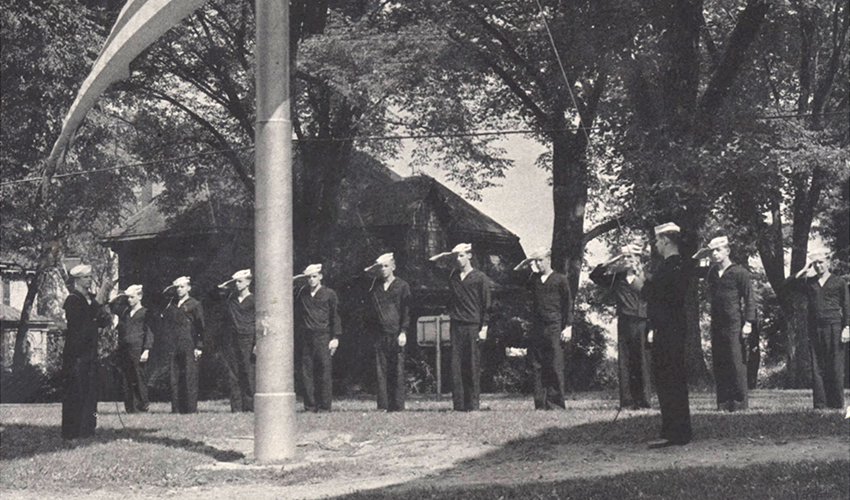
Reflections on 75th Anniversary of Pearl Harbor
7 December 2016 Reflections on 75th Anniversary of Pearl Harbor
Commemorating the 75th anniversary of the attack on Pearl Harbor, Hobart and William Smith Colleges will fly flags at half-staff and reflect on the transformations, both national and on campus, following Dec. 7, 1941.
Like colleges and  universities across the country, after the attack HWS became invested in supporting the war efforts at home and abroad. In 1943, then HWS President John Milton Potter launched the Navy V-12 training program, bringing an influx of young naval officers to the Colleges at a time when enrollment was hovering just below 30 students. The V-12 program enabled unit members to attend classes with HWS students and work toward a bachelors degree, all while training to enter the war.
universities across the country, after the attack HWS became invested in supporting the war efforts at home and abroad. In 1943, then HWS President John Milton Potter launched the Navy V-12 training program, bringing an influx of young naval officers to the Colleges at a time when enrollment was hovering just below 30 students. The V-12 program enabled unit members to attend classes with HWS students and work toward a bachelors degree, all while training to enter the war.
From 1943 until the end of the war in 1945, the unit of naval officers could be seen assembling and marching across the Quad to Coxe Hall for daily inspections and training. Even after the program and the war ended, the effects on campus continued as the G.I. Bill brought in hundreds of veterans seeking higher education.
Warren Shaddock 46, P 75, GP 09was a senior at Brighton High School in Rochester, N.Y., when the attack on Pearl Harbor occurred. Preparing to attend Hobart as a pre-med/pre-dental student, Shaddocks plans changed course when the Navy V-12 program was established in the spring of his first year at the Colleges. After his initial training at Hobart, Shaddock was sent to midshipman school at Columbia University, and then to Harvard University for communications school, where he was trained to use a top secret electronic coding machine. Aboard USS Calvert APA-32, Shaddock was commissioned to Pearl Harbor and later sent to occupy Japan.
 We were anchored about seven miles from Hiroshima so out of curiosity a group of us took one of our landing crafts over to see it, Shaddock remembers. I believe we were some of the first Americans to see what it looked like after the dropping of the bomb. It was just miles and miles of utter destruction. We found stacks of dishes that had been fused together by the heat of the bomb, and gravel that had been fused to a porcelain pitcher.
We were anchored about seven miles from Hiroshima so out of curiosity a group of us took one of our landing crafts over to see it, Shaddock remembers. I believe we were some of the first Americans to see what it looked like after the dropping of the bomb. It was just miles and miles of utter destruction. We found stacks of dishes that had been fused together by the heat of the bomb, and gravel that had been fused to a porcelain pitcher.
After leaving Japan, Shaddock received orders to return to Pearl Harbor at the command post of the amphibious forces until he had enough points to return to civilian life. He returned to Hobart, completing a final semester to earn his B.S. in biology and chemistry.
Grady Jensen 44, P 83, L.H.D. 04, a former HWS Trustee, graduated before the V-12 program was launched on campus, but remembers well the atmosphere at Hobart and William Smith as the U.S. prepared to enter battle.
I remember very specifically when Pearl Harbor happened on December 7, he says. I was in the Kappa Sigma Fraternity House, and a bunch of us were sitting around, and that Sunday afternoon when the news came on over the radio about Pearl Harbor we all just couldnt believe it. They announced that President Roosevelt was going to speak the next morning, so we all crowded around in one of the lounges and listened to him calling for the vote to go to war. I wrote down in a journal that I could feel the hairs on the back of my head standing up because we all knew sooner or later we were going to get called into war ourselves.
Jensen graduated from Hobart in three years and joined the Navy Aviation cadet training program. Though never called into active duty, Jensen remained active in the Naval Reserve and once flew a torpedo bomber to visit the Colleges, a trip that was featured in a Finger Lakes Times editorial detailing his dangerous travels.
Read more about these alums and others, and their reflections on World War II, in the Pulteney St. Survey.
